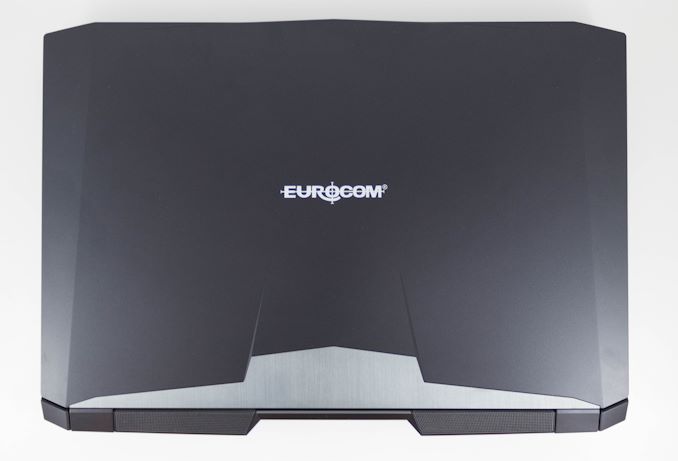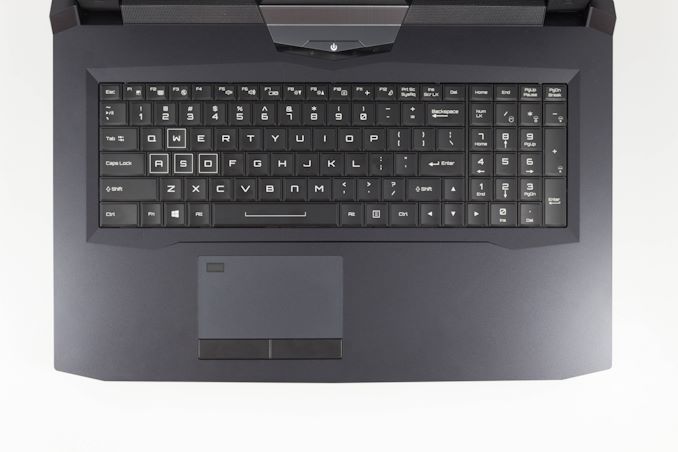The Eurocom Sky X7C (Clevo P775TM1-G) Gaming Laptop Review: True Desktop Replacement
by Brett Howse on August 5, 2019 8:00 AM ESTDesign
Eurocom is leveraging the Clevo P775TM1-G laptop as their base chassis for the Sky X7C, and if you’ve ever had a chance to use a Clevo laptop before, it is certainly function over form in every respect. There’s no fancy aluminum CNC chassis, but instead a big, bold, black plastic exterior, with no fancy graphics or lighting. Every dollar you pay goes into what is inside, rather than outside.
The Eurocom Sky X7C is a big laptop. It measures 40 mm / 1.6-inches thick and weighs in at a hefty 3.9 kg / 8.58 lbs. This is true desktop replacement territory, offering the size and weight to be able to handle the extra cooling that the desktop class components will require. As a DTR notebook, it’s meant to be moved from desk to desk, rather than used on the go.
The no-nonsense black plastic continues when you lift the display open. This notebook doesn’t offer the ultra-thin bezels you may expect on a smaller, lighter laptop, and the imposing size doesn’t offer the modern look from some of the more expensive competition.
If you are familiar with Clevo keyboards, this is as standard as they come. Clevo offers a full keyboard plus number pad, and it offers reasonable key feel and throw. There’s only three zones of RGB backlighting, rather than per-key like some of the competition, which limits the usefulness of the backlighting for anything other than being able to see in the dark. Per-key does offer some benefits to quickly find certain keys, or change the mapping based on application, whereas three zones, to me, looks a bit silly if all of the zones are not set to the same color.
The trackpad offers the same no-nonsense approach, with a pretty average trackpad. There’s no glass top for smoothness, but it is responsive enough and works well with multi-touch. There’s also actual buttons located below the trackpad, which is beneficial for gaming if you don’t have access to a mouse. Clevo also includes a fingerprint reader in the trackpad as an added convenience.
The sides of the laptop offer plenty of expansion ports, with four USB Type-A ports split across the right and left, and two USB Type-C ports on the left side. There’s also a SD card reader and Ethernet on the left, and four 3.5 mm jacks for the audio on the right. If there’s a small quibble here, it would be that the Ethernet cable should be located on the rear to make the cabling a bit cleaner if you do want to use wired Ethernet, where it would join the two DisplayPort outputs, the HDMI 2.0 port, and the massive 4-pin power connector.
Clevo laptops are function over form, which is really their charm, and allows them to offer more performance for less cost than most, if not all, of the competition. The design of the Eurocom Sky X7C is typical Clevo, but it still offers a reasonable keyboard and trackpad even if the overall fit, finish, and feel don’t quite stack up with the sleek aluminum you’d normally see on a gaming laptop in this price range. There’s plenty of expansion, and you could easily run this as a true desktop with a display, keyboard, and mouse connected with no fuss.
















46 Comments
View All Comments
DanNeely - Monday, August 5, 2019 - link
It's good to see that 1440p laptop screens aren't dead yet (4k is overkill for high DPI uses) even if this model gives a rather poor showing.anactoraaron - Monday, August 5, 2019 - link
$4,000 machine with literally the cheapest display they could find. Just embarrassing.airdrifting - Monday, August 5, 2019 - link
While it might be equipped with a desktop 9900K, it will never run the same speed and temperature as desktop counter parts. 9900K is notorious to overheat and I have seen it easily hit high 90C during Realbench with many motherboards WITHOUT overclocking using out of the box default settings (AIO liquid cooling), good luck getting it to run inside a tiny laptop. I have to manually lower voltage on most motherboards just to keep 9900K under 80C full load since most motherboards set like a ridiculous 1.2-1.3V voltage by default.MrRuckus - Monday, August 5, 2019 - link
If you read the article you would see they did exactly that. Loaded down the proc and were hitting 87c under load. Maintaining 4100-4200Mhz is very commendable in a laptop form factor. There could be more performance to be had by undervolting the Proc. As you say you do it on a desktop, it goes double for a laptop and can do wonders for throttling if there is any present. 80-90c is par for the course on Laptops that are desktop replacements.airdrifting - Tuesday, August 6, 2019 - link
"Maintaining 4100-4200Mhz is very commendable in a laptop form factor." 9900K on desktop Z390 motherboards is able to maintain 4.7GHz all core turbo. Now go back to read what I said in the very first sentence: "While it might be equipped with a desktop 9900K, it will never run the same speed and temperature as desktop counter parts." 4.1GHz < 4.7GHz, point proven.eastcoast_pete - Monday, August 5, 2019 - link
Thanks Brett! I have a soft spot for these DTRs (I like the even older name for them: luggables). I wonder if Clevo&Co. could come up with a true hybrid design: portable notebook format with socketed CPU, and the main second GPU in a docking station with integrated large PSU, connected via a PCIE3-16 (or PCIE4) snap-in connector, all in a case with a handle. That would give the graphics more thermal headroom, and avoid the potential bottleneck of running the dGPU over TB3. And, with an optional smaller, maybe GTX dGPU card on board, the laptop itself would still be quite capable.MrRuckus - Monday, August 5, 2019 - link
I think TB3 is going to be your best bet. I dont think external PCIe is going to be a thing due to length limitations and a needed external connector of some kind. The ribbon connectors aren't exactly made for unplugging and plugging in 100's of times. They have people who have done it, but the implementation is pretty wonky and you gotta have access to a Wifi card slot to do it. If I remember right they are also limited to PCIex1 so the difference between that and thunderbolt, thunderbolt can actually be faster. Just better off getting a laptop with a true thunderbolt 3.0 slot that can push 40gbps = PCIex4. Maybe Thunderbolt 4 will offer a true pound for pound replacement and get the throughput closer to 100% instead of the 70-80% now on external GPUs.imaheadcase - Monday, August 5, 2019 - link
Um no laptop is a gaming desktop replacement.You literally showed it wasn't by the specs. THe price is insanely expensive, and the screen is laughable.
bennyg - Tuesday, August 6, 2019 - link
It's not cheap. The particular panel has just been plagued with issues since it was first put in these 17" models in 2015/2016. The original B173QTN01.0 had horrible banding on alternating rows of pixels and the individual panels are quite variable. This would be a 1.2 or 1.4 revision I'm guessing. A colour calibration is necessary for this panel in particular. But its the only >1080p 120Hz out there.I have a P870DM3 with the same 17" 4K IPS panel that's an option for this P775, being 400nit 95% gamut and good colour accuracy it's the content creation and general beautifulness option, but it's transition of >20ms is not great for fast games.
bennyg - Tuesday, August 6, 2019 - link
No idea how my reply got here, it was to the guy bagging the "cheap" panel on about page 4 of the comments.Same old stuff going on in the comment section at AT....